英汉翻译+-课件(ppt·精选)
- 格式:ppt
- 大小:2.06 MB
- 文档页数:37

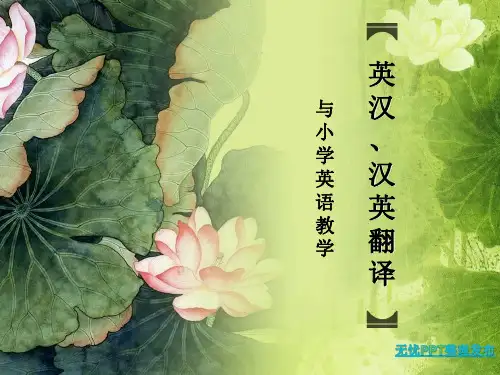
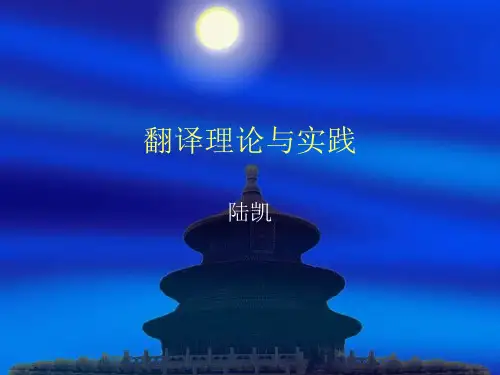
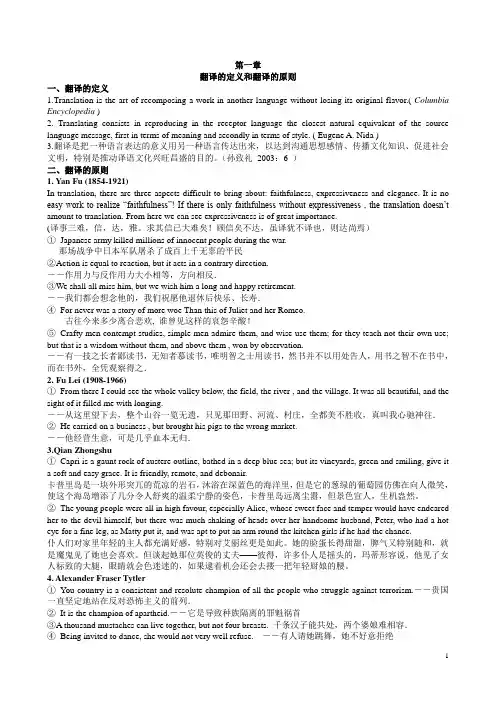
第一章翻译的定义和翻译的原则一、翻译的定义1.Translation is the art of recomposing a work in another language without losing its original flavor.( Columbia Encyclopedia )2. Translating consists in reproducing in the receptor language the closest natural equivalent of the source language message, first in terms of meaning and secondly in terms of style. ( Eugene A. Nida )3.翻译是把一种语言表达的意义用另一种语言传达出来,以达到沟通思想感情、传播文化知识、促进社会文明,特别是推动译语文化兴旺昌盛的目的。
(孙致礼2003:6 )二、翻译的原则1. Yan Fu (1854-1921)In translation, there are three aspects difficult to bring about: faithfulness, expressiveness and elegance. It is no easy work to realize ―faithfulness‖! If there is only faithfulness without expressiveness , the translation doesn’t amount to translation. From here we can see expressiveness is of great importance.(译事三难,信,达,雅。
求其信已大难矣!顾信矣不达,虽译犹不译也,则达尚焉)①Japanese army killed millions of innocent people during the war.----那场战争中日本军队屠杀了成百上千无辜的平民②Action is equal to reaction, but it acts in a contrary direction.――作用力与反作用力大小相等,方向相反.③We shall all miss him, but we wish him a long and happy retirement.――我们都会想念他的,我们祝愿他退休后快乐、长寿.④For never was a story of more woe Than this of Juliet and her Romeo.古往今来多少离合悲欢, 谁曾见这样的哀怨辛酸!⑤Crafty men contempt studies, simple men admire them, and wise use them; for they teach not their own use; but that is a wisdom without them, and above them , won by observation.――有一技之长者鄙读书,无知者慕读书,唯明智之士用读书,然书并不以用处告人,用书之智不在书中,而在书外,全凭观察得之.2. Fu Lei (1908-1966)①From there I could see the whole valley below, the field, the river , and the village. It was all beautiful, and the sight of it filled me with longing.――从这里望下去,整个山谷一览无遗,只见那田野、河流、村庄,全都美不胜收,真叫我心驰神往.②He carried on a business , but brought his pigs to the wrong market.――他经营生意,可是几乎血本无归.3.Qian Zhongshu①Capri is a gaunt rock of austere outline, bathed in a deep blue sea; but its vineyards, green and smiling, give ita soft and easy grace. It is friendly, remote, and debonair.卡普里岛是一块外形突兀的荒凉的岩石,沐浴在深蓝色的海洋里,但是它的葱绿的葡萄园仿佛在向人微笑,使这个海岛增添了几分令人舒爽的温柔宁静的姿色,卡普里岛远离尘嚣,但景色宣人,生机盎然。

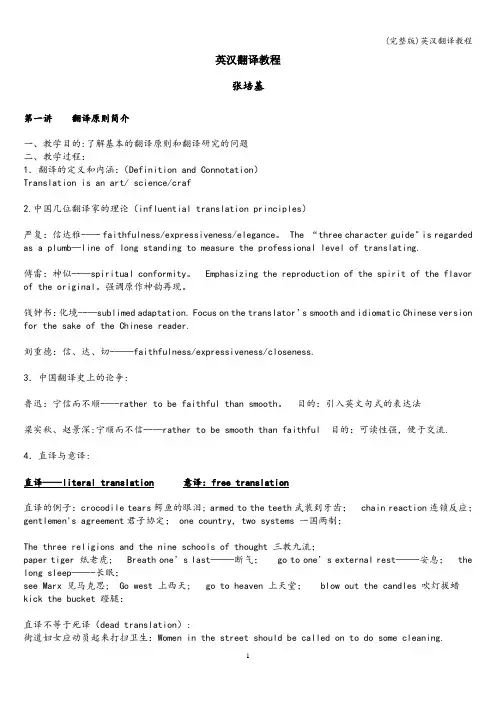
英汉翻译教程张培基第一讲翻译原则简介一、教学目的:了解基本的翻译原则和翻译研究的问题二、教学过程:1.翻译的定义和内涵:(Definition and Connotation)Translation is an art/ science/craf2.中国几位翻译家的理论(influential translation principles)严复:信达雅-—- faithfulness/expressiveness/elegance。
The “three character guide" is regarded as a plumb—line of long standing to measure the professional level of translating.傅雷:神似--—spiritual conformity。
Emphasizing the reproduction of the spirit of the flavor of the original。
强调原作神韵再现。
钱钟书:化境--—sublimed adaptation. Focus on the translator’s smooth and idiomatic Chinese version for the sake of the Chinese reader.刘重德:信、达、切-——faithfulness/expressiveness/closeness.3.中国翻译史上的论争:鲁迅:宁信而不顺-—-rather to be faithful than smooth。
目的:引入英文句式的表达法梁实秋、赵景深:宁顺而不信--—rather to be smooth than faithful 目的:可读性强,便于交流.4.直译与意译:直译—--literal translation意译:free translation直译的例子:crocodile tears鳄鱼的眼泪; armed to the teeth武装到牙齿; chain reaction连锁反应;gentlemen's agreement君子协定; one country, two systems 一国两制;The three religions and the nine schools of thought 三教九流;paper tiger 纸老虎; Breath one’s last——-断气; go to one’s external rest——-安息; the long sleep——-长眠;see Marx 见马克思; Go west 上西天; go to heaven 上天堂; blow out the candles 吹灯拔蜡kick the bucket 蹬腿:直译不等于死译(dead translation):街道妇女应动员起来打扫卫生:Women in the street should be called on to do some cleaning.“In the street" should be replaced by “in the community”.她一大早起床,进城,见到了她的公爹:She got up early, went to the town and saw her public father。
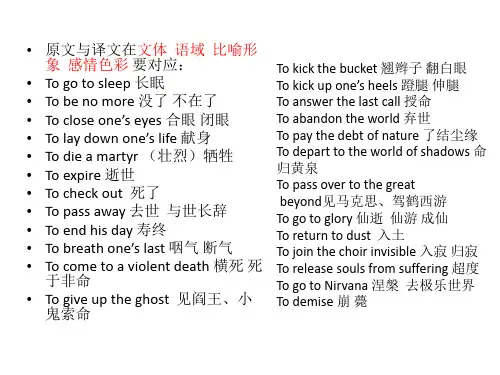

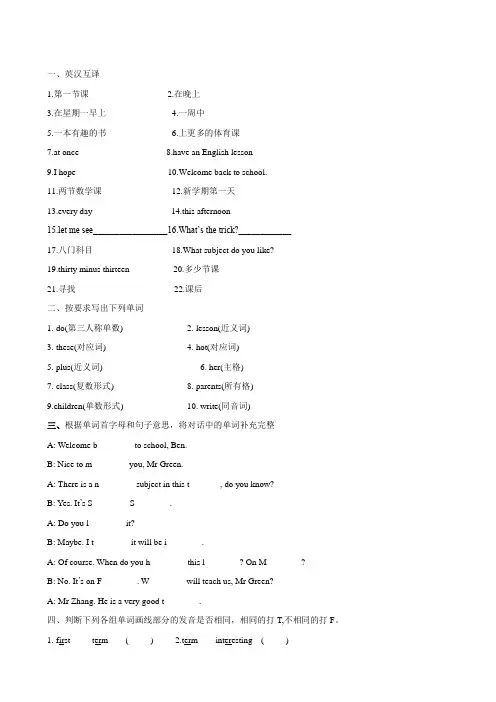
一、英汉互译1.第一节课__________________2.在晚上_____________________3.在星期一早上_______________4.一周中_____________________5.一本有趣的书_______________6.上更多的体育课______________7.at once____________________8.have an English lesson_________9.I hope_____________________10.Welcome back to school._______11.两节数学课________________12.新学期第一天________________13.every day__________________14.this afternoon_______________15.let me see_________________16.What’s the trick?____________17.八门科目__________________18.What subject do you like?______19.thirty minus thirteen__________20.多少节课___________________21.寻找______________________ 22.课后_______________________二、按要求写出下列单词1. do(第三人称单数)__________2. lesson(近义词) __________3. these(对应词) __________4. hot(对应词) __________5. plus(近义词) __________6. her(主格) __________7. class(复数形式) __________ 8. parents(所有格) __________9.children(单数形式) __________ 10. write(同音词) __________三、根据单词首字母和句子意思,将对话中的单词补充完整A: Welcome b________ to school, Ben.B: Nice to m________ you, Mr Green.A: There is a n________ subject in this t_______, do you know?B: Yes. It’s S________ S________.A: Do you l________ it?B: Maybe. I t________ it will be i________.A: Of course. When do you h________ this l________? On M________?B: No. It’s on F________. W________ will teach us, Mr Green?A: Mr Zhang. He is a very good t________.四、判断下列各组单词画线部分的发音是否相同,相同的打T,不相同的打F。
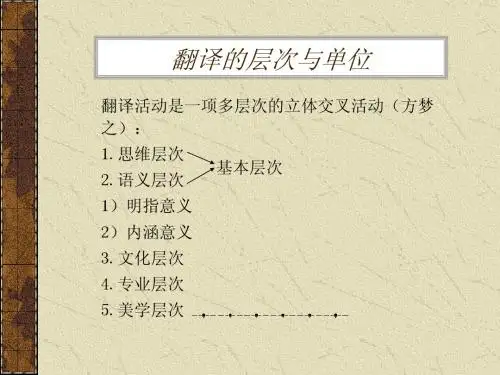

英汉互译英汉1. 什么是英汉互译?英汉互译是指将英语和汉语之间进行相互转换的过程。
在全球化的背景下,英语作为一种国际通用语言,与汉语的关系日益密切。
因此,掌握英汉互译技能对于沟通交流、文化交流以及跨文化交流具有重要意义。
2. 英汉互译的难点尽管英语和汉语都属于世界上最重要的语言之一,但由于两种语言在表达方式、句法结构、文化内涵等方面存在差异,因此进行英汉互译时会遇到一些难点。
2.1 文化差异中西方文化存在明显的差异,这也反映在了两种语言之间。
例如,在英文中,“猫”被描述为“cat”,而在中文中,“猫”被描述为“猫”。
这种差异不仅仅是表达方式上的区别,更体现了两种文化对事物的理解和认知。
2.2 句法结构句法结构是指一个句子中各个成分之间的关系和顺序。
英语和汉语的句法结构存在一些差异,例如,英语中主语+谓语+宾语的顺序在汉语中可能会被颠倒。
这就需要在互译过程中灵活运用句法结构的变化。
2.3 习惯用语和俚语习惯用语和俚语是两种语言中常见的表达方式。
然而,由于文化背景和社会环境的不同,英汉互译时可能会遇到一些习惯用语和俚语难以直接对应的情况。
这时候需要通过理解其内涵和寻找相似表达来进行翻译。
3. 英汉互译技巧为了有效地进行英汉互译,以下是一些实用的技巧:3.1 理解上下文理解上下文是进行准确翻译的关键。
通过仔细阅读原文并分析上下文,可以更好地理解句子的意思、情感色彩以及所传递的信息。
只有充分理解了原文,才能更好地进行翻译。
3.2 注重准确性和流畅性在进行英汉互译时,要注重翻译的准确性和流畅性。
准确性是指翻译结果与原文的一致性,而流畅性则是指翻译结果在语言表达上的自然和流畅。
只有兼顾准确性和流畅性,才能使翻译更加贴近原文。
3.3 学习常见表达学习常见表达是提高英汉互译能力的重要途径。
通过积累常见的表达方式、短语和句型,可以更好地应对各种翻译任务。
在学习中应注重实践,通过大量阅读、写作和口语练习来提高自己的英汉互译能力。
第三讲原文的理解和转换Unit 03 Understanding & T ranslation翻译下面的句子。
1.而今适逢西南交通大学百年华诞,世纪庆典,共襄盛举,追忆往事,铭记在心,勒石流芳,以垂后世。
On this special occasion when Southwest Jiaotong University is marking its centenary anniversary, we recall the unforgettable past, write it down and engrave it on the memorial stone tablet so that it will be remembered by all the generations to come. 2.警察监视着犯罪嫌疑人的一举一动。
The police kept close watch on the man under suspicion.3.我们是新雇员,得注意自己的一举一动。
As new employees we must be careful about what we do.4.我常见许多青年的朋友,聪明用功,成绩优异,而语文程度不足以达意,甚至写一封信亦难得通顺,问其故则曰其兴趣不在语文方面。
I have come across a great many bright and diligent young friends who have doneexceedingly well in their studies, but are rather weak in Chinese. They cannot even write a letter in correct Chinese. When I asked them why, they said they were not interested in the Chinese language.5.Britain could not have advanced her industrialization so rapidly if, just when ownersof factories needed it most, an abundant supply of cheap labour had not made itself available.要不是正好在工厂老板们最需要劳动力的时候得到大量廉价劳动力,英国的工业化就不可能发展得这样迅速。
中英汉互译
1. 英文翻译成中文:
- 书籍是人类进步的阶梯。
Books are the ladder of human progress.
- 生活就像一面镜子,你若对她笑,她就对你笑。
Life is like a mirror. If you smile at her, she will smile at you.
2. 中文翻译成英文:
- 知识就是力量。
Knowledge is power.
- 塞翁失马,焉知非福。
A blessing in disguise.
3. 中文翻译成中文:
- 天下兴亡,匹夫有责。
Everyone is responsible for the rise and fall of the country.
- 海纳百川,有容乃大。
The ocean is vast because it admits all rivers.
这些只是一些示例,实际上还有很多其他的中英汉互译内容。
如果你有具体的文本需要翻译,我可以帮你进行翻译。
请注意,翻译的准确性和流畅性可能会受到语言的复杂性、文化背景和上下文等因素的影响。